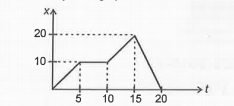The displacement 'x' (in meter) of a particle of mass 'm' (in kg) moving in one dimension under the action of a force is released to time 't' (in sec) by t2=√x+2. The displacement of the particle when its velocity is zero will be.
The correct Answer is:4mor0m
To solve the problem step by step, we will analyze the relationship between displacement x and time t, find the velocity, and determine the displacement when the velocity is zero.
Step 1: Start with the given equation
The relationship between displacement x and time t is given by:
t2=√x+2
Step 2: Rearrange the equation
We can rearrange the equation to isolate √x:
√x=t2−2
Step 3: Square both sides to solve for x
Now, squaring both sides gives:
x=(t2−2)2
Step 4: Expand the equation
Expanding the right-hand side:
x=t4−4t2+4
Step 5: Differentiate to find velocity
The velocity v is defined as the derivative of displacement with respect to time:
v=dxdt
Differentiating x:
v=ddt(t4−4t2+4)
Using the power rule:
v=4t3−8t
Step 6: Set velocity to zero
To find when the velocity is zero, we set the equation to zero:
4t3−8t=0
Step 7: Factor the equation
Factoring out 4t:
4t(t2−2)=0
This gives us two factors:
1. 4t=0 → t=0
2. t2−2=0 → t=±√2
Step 8: Find corresponding displacements
Now we will find the displacement x for each value of t.
1. For t=0:
x=(02−2)2=(−2)2=4 meters
2. For t=√2:
x=(√22−2)2=(2−2)2=0 meters
3. For t=−√2:
x=((−√2)2−2)2=(2−2)2=0 meters
Step 9: Conclusion
The displacement of the particle when its velocity is zero can be either:
- 4 meters (when t=0)
- 0 meters (when t=√2 or t=−√2)
Summary of Results
The possible displacements when the velocity is zero are 4 meters and 0 meters.
---
The relationship between displacement x and time t is given by:
t2=√x+2
We can rearrange the equation to isolate √x:
√x=t2−2
Now, squaring both sides gives:
x=(t2−2)2
Expanding the right-hand side:
x=t4−4t2+4
The velocity v is defined as the derivative of displacement with respect to time:
v=dxdt
Differentiating x:
v=ddt(t4−4t2+4)
Using the power rule:
v=4t3−8t
To find when the velocity is zero, we set the equation to zero:
4t3−8t=0
Factoring out 4t:
4t(t2−2)=0
This gives us two factors:
1. 4t=0 → t=0
2. t2−2=0 → t=±√2
Now we will find the displacement x for each value of t.
x=(02−2)2=(−2)2=4 meters
x=(√22−2)2=(2−2)2=0 meters
x=((−√2)2−2)2=(2−2)2=0 meters
The displacement of the particle when its velocity is zero can be either:
- 4 meters (when t=0)
- 0 meters (when t=√2 or t=−√2)
The possible displacements when the velocity is zero are 4 meters and 0 meters.
Topper's Solved these Questions
- MOTION IN A STRAIGHT LINEBOOK - AAKASH INSTITUTE ENGLISHCHAPTER - MOTION IN A STRAIGHT LINEEXERCISE - ASSIGNMENT (SECTION - D)
15 Videos
- MOTION IN A STRAIGHT LINEBOOK - AAKASH INSTITUTE ENGLISHCHAPTER - MOTION IN A STRAIGHT LINEEXERCISE - ASSIGNMENT (SECTION - B)
33 Videos
- MOTION IN A PLANEBOOK - AAKASH INSTITUTE ENGLISHCHAPTER - MOTION IN A PLANEEXERCISE - Assignement section -J (Aakash Challengers Questions)
7 Videos
- MOTION IN STRAIGHT LINEBOOK - AAKASH INSTITUTE ENGLISHCHAPTER - MOTION IN STRAIGHT LINEEXERCISE - Assignment (SECTION - J)
2 Videos
Similar Questions
The displacement x of a particle moving in one dimension under the action of a constant force is related to time t by the equation t=√x+3, where x is in meter and t is in second. Find the displacement of the particle when its velocity is zero.
View SolutionThe displacement x of particle moving in one dimension, under the action of a constant force is related to the time t by the equation t=√x+3
where xis∈metersandt∈seconds . Find
(i) The displacement of the particle when its velocity is zero , and
(ii) The work done by the force in the first 6seconds.
View SolutionFor a particle displacement time relation is t=√x+3. Its displacement when its velocity is zero -
View SolutionIf the displacement of a particle varies with time as √x=t+3
View SolutionFor a particle moving in a straight line, the displacement of the particle at time t is given by
S=t3−6t2+3t+7
What is the velocity of the particle when its acceleration is zero?
View SolutionFor a particle moving in a straight line, the displacement of the particle at time t is given by
S=t3−6t2+3t+7
What is the velocity of the particle when its acceleration is zero?
View SolutionThe displacement of a particle moving along the x-axis is given by equation x=2t3−21t2+60t+6.The possible acceleration of the particle when its velocity is zero is
View SolutionGraph of displacement (X) VS time (t) is given below for a particle moving in one-dimensional motion. The velocity time graph for this case would be

View SolutionThe position of a particle moving along x-axis given by x=(−2t3−3t2+5)m. The acceleration of particle at the instant its velocity becomes zero is
View SolutionThe relation 3t=√3x+6 describe the displacement of a particle in one direction where x is in metres and t in sec.
The displacement, when velocity is zero is
View Solution
